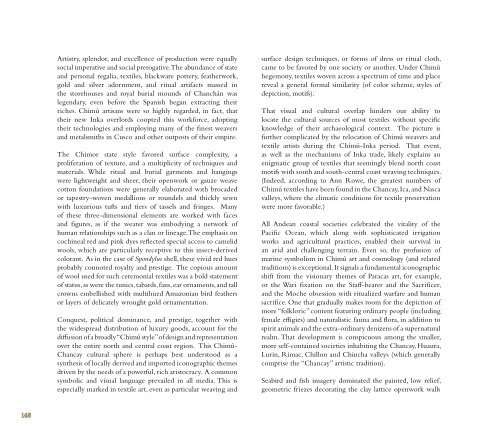Create successful ePaper yourself
Turn your PDF publications into a flip-book with our unique Google optimized e-Paper software.
Artistry, splendor, and excellence of production were equally<br />
social imperative and social prerogative. The abundance of state<br />
and personal regalia, textiles, blackware pottery, fea<strong>the</strong>rwork,<br />
gold and silver adornment, and ritual artifacts massed in<br />
<strong>the</strong> storehouses and royal burial mounds of Chanchán was<br />
legendary, even before <strong>the</strong> Spanish began extracting <strong>the</strong>ir<br />
riches. Chimú artisans were so highly regarded, in fact, that<br />
<strong>the</strong>ir new Inka overlords coopted this workforce, adopting<br />
<strong>the</strong>ir technologies and employing many of <strong>the</strong> finest weavers<br />
and metalsmiths in Cusco and o<strong>the</strong>r outposts of <strong>the</strong>ir empire.<br />
The Chimor state style favored surface complexity, a<br />
proliferation of texture, and a multiplicity of techniques and<br />
materials. While ritual and burial garments and hangings<br />
were lightweight and sheer, <strong>the</strong>ir openwork or gauze weave<br />
cotton foundations were generally elaborated with brocaded<br />
or tapestry-woven medallions or roundels and thickly sewn<br />
with luxurious tufts and tiers of tassels and fringes. Many<br />
of <strong>the</strong>se three-dimensional elements are worked with faces<br />
and figures, as if <strong>the</strong> wearer was embodying a network of<br />
human relationships such as a clan or lineage. The emphasis on<br />
cochineal red and pink dyes reflected special access to camelid<br />
wools, which are particularly receptive to this insect-derived<br />
colorant. As in <strong>the</strong> case of Spondylus shell, <strong>the</strong>se vivid red hues<br />
probably connoted royalty and prestige. The copious amount<br />
of wool used for such ceremonial textiles was a bold statement<br />
of status, as were <strong>the</strong> tunics, tabards, fans, ear ornaments, and tall<br />
crowns embellished with multihued Amazonian bird fea<strong>the</strong>rs<br />
or layers of delicately wrought gold ornamentation.<br />
Conquest, political dominance, and prestige, toge<strong>the</strong>r with<br />
<strong>the</strong> widespread distribution of luxury goods, account for <strong>the</strong><br />
diffusion of a broadly “Chimú style” of design and representation<br />
over <strong>the</strong> entire north and central coast region. This Chimú-<br />
Chancay cultural sphere is perhaps best understood as a<br />
syn<strong>the</strong>sis of locally derived and imported iconographic <strong>the</strong>mes<br />
driven by <strong>the</strong> needs of a powerful, rich aristocracy. A common<br />
symbolic and visual language prevailed in all media. This is<br />
especially marked in textile art, even as particular weaving and<br />
surface design techniques, or forms of dress or ritual cloth,<br />
came to be favored by one society or ano<strong>the</strong>r. Under Chimú<br />
hegemony, textiles woven across a spectrum of time and place<br />
reveal a general formal similarity (of color scheme, styles of<br />
depiction, motifs).<br />
That visual and cultural overlap hinders our ability to<br />
locate <strong>the</strong> cultural sources of most textiles without specific<br />
knowledge of <strong>the</strong>ir archaeological context. The picture is<br />
fur<strong>the</strong>r complicated by <strong>the</strong> relocation of Chimú weavers and<br />
textile artists during <strong>the</strong> Chimú-Inka period. That event,<br />
as well as <strong>the</strong> mechanisms of Inka trade, likely explains an<br />
enigmatic group of textiles that seemingly blend north coast<br />
motifs with south and south-central coast weaving techniques.<br />
(Indeed, according to Ann Rowe, <strong>the</strong> greatest numbers of<br />
Chimú textiles have been found in <strong>the</strong> Chancay, Ica, and Nasca<br />
valleys, where <strong>the</strong> climatic conditions for textile preservation<br />
were more favorable.)<br />
All Andean coastal societies celebrated <strong>the</strong> vitality of <strong>the</strong><br />
Pacific Ocean, which along with sophisticated irrigation<br />
works and agricultural practices, enabled <strong>the</strong>ir survival in<br />
an arid and challenging terrain. Even so, <strong>the</strong> profusion of<br />
marine symbolism in Chimú art and cosmology (and related<br />
traditions) is exceptional. It signals a fundamental iconographic<br />
shift from <strong>the</strong> visionary <strong>the</strong>mes of Paracas art, for example,<br />
or <strong>the</strong> Wari fixation on <strong>the</strong> Staff-bearer and <strong>the</strong> Sacrificer,<br />
and <strong>the</strong> Moche obsession with ritualized warfare and human<br />
sacrifice. One that gradually makes room for <strong>the</strong> depiction of<br />
more “folkloric” content featuring ordinary people (including<br />
female effigies) and naturalistic fauna and flora, in addition to<br />
spirit animals and <strong>the</strong> extra-ordinary denizens of a supernatural<br />
realm. That development is conspicuous among <strong>the</strong> smaller,<br />
more self-contained societies inhabiting <strong>the</strong> Chancay, Huaura,<br />
Lurin, Rimac, Chillon and Chincha valleys (which generally<br />
comprise <strong>the</strong> “Chancay” artistic tradition).<br />
Seabird and fish imagery dominated <strong>the</strong> painted, low relief,<br />
geometric friezes decorating <strong>the</strong> clay lattice openwork walls<br />
168







